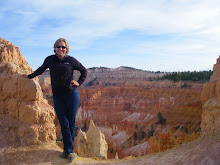Activists of every breed know that intrinsic value of having the right terminology. It’s hard to argue against being “Pro-life” or fight for support of female genital mutilation, but when you discuss being “anti-abortion” or the cultural value of circumcision traditions, it changes the shape of the debate. The power to set the tone for the debate is in the terminology. From this word-power perspective, the global movement to reduce anthropogenic greenhouse gas pollution that is increasing the earth’s insulation and raising temperature is stuck between a rock and a hard place.
They started with “global warming” but that became political incorrect when many people refused to believe the evidence. Now, the evidence has been accepted as “Unequivocal” by the IPCC, and we’re all using the politically correct “Climate Change.” Although it was chosen to emphasize that greenhouse gases will do more damage to the planet than just kick up the thermostat a few degrees, climate change lacks the oomph of a true activist expression.
Worse, as skeptics and a few remaining oil executives will be quick to point out, the climate is always changing, climate change is nothing new or concerning. The frustrating part is that they are right. Climate changes are normal, but we’ve still got a serious problem on our hands with carbon dioxide and its friends. So perhaps we need to find a new word to rally behind, and to do that we need to think about what it about our changing climate we really want to talk about.
Climate is controlled by many factors, on many levels.
For a broad analysis, we can consider climate as being driven by three categories of factors, also known in climatologist lingo as “forcings”. The first category would be external forcings. This includes variations in the Earth’s orbit known as Milankovitch cycles. The planet’s tilt, the curvature of the orbit, and the earth’s wobble on its axis vary on cycles of 23, 41, and about 100 thousand years, and these patterns give rise to the well documented approximately 100,000 year ice age cycles. Other forcings in this category would include variations in incoming solar energy.
The second category of forcings can be considered natural internal forcings. Varying from annual to decadal influences, processes like the El Nino Southern Oscillation and the Pacific Decadal Oscillation fall into this category. Changes in sea surface temperature and circulation interacts with the atmosphere circulation patterns to change winds, temperatures, and precipitation. Some of these mechanisms, like the ENSO are well understood by scientists, and other undoubtedly have yet to be concretely described.
The third category of climate influences would be anthropogenic internal forcing. This category includes all kinds of factors like deforestation and the accumulation of carbon dioxide in the atmosphere from fossil fuel combustion. Other human forces include aerosol and sulfide pollutions, smog pollutants which actually have a net cooling effect as the pollution clouds reflect solar energy away in a process recently dubbed “global dimming.” Which is not to say that more smog is our solution to our global warming problem, but to demonstrate that our climate is a complicated concept.
Which makes it all the more concerning that human activity is having such a huge impact on the global climate, altering the system before we’ve even completely figured it out. We’ve got a problem because the third category of forcings is rapidly exceeding the natural variation of the natural factors, and we’re driving ourselves into uncharted territory. The climate is most definitely changing, in ways that we need to be concerned about. But saying that we need to fight “anthropogenic greenhouse gas driven global climate change” is a rather uninspiring mouthful. We’re facing more that just temperature increases and changes, we’re facing a complex network of global climate disruptions that will feed off one another in ways scientists are just beginning to predict. We all know we need to act sooner rather than later or too late if we want to preserve the world that has taken such good care of us so far. I don’t know what the battle cry should be, but the sooner we find it, the better.
4 years ago


No comments:
Post a Comment